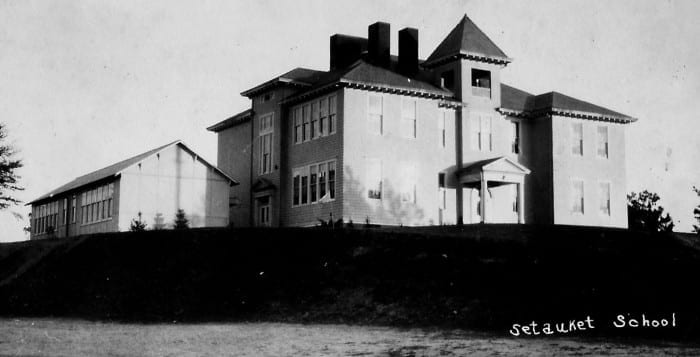Three Village schoolmates a staple of community life

By Beverly C. Tyler
My daily experiences in the community around me in the 1940s and ‘50s was an extension of my experiences at school.
The first seven-and-a-half years I attended the Setauket Union Free School on the hill in East Setauket. We had lessons and studying, but most of that is a blur of unremembered activity in the classroom. The real school day consisted of relationships with many of the same people I would see outside the classroom setting. Brief, but wonderful, free times each day on the school playground, on the grassy areas around the school building and on the school field were times to talk and play with classmates and other kids.
We were outside winter and summer, even occasionally when it was raining and definitely when it was snowing. While we played, we joked and talked about teachers, about each other and many things that really didn’t matter, but they were shared experiences.
We knew a lot about each other without ever really spelling it out, and we had no idea how close we were to each other. We cared, we shared, we laughed and we occasionally cried, and we did it face to face every day.
Most of the kids around my age lived within a couple of miles of the school, and many lived within walking distance. I took the bus most days, especially when the weather was bad, driven by Jesse Eikov or one of his other bus drivers like Bill Owen or Gene Hutchinson.
Sometimes a few of us would walk the mile to school, but, since there was so much to do along the way, we were in danger of being late. In the first couple of years in school, explorations into the community and neighborhood around my home and between home and the school were done with my family.
By the time I was in third or fourth grade, it was mostly with schoolmates and friends around my age. We explored woods, fields, ponds, streams, wetlands, abandoned buildings and neighbors’ yards with abandon. We easily walked and biked a mile or two from home without any concern from our parents. Many of our schoolmates and friends had parents that worked in the local area.
Our schoolmates’ parents ran the East Setauket stores, and many of our teachers lived close by, often too close when we were not behaving the way we knew we should.
We never called each other on the phone; we just met on the street after school and on weekends. We were always at the post office in Setauket when the mail was delivered from the train around 6 p.m.
Everyone in the community picked up their mail between about 6 and 6:30 p.m. We hung around near the post office where the old men sat on the benches outside and smoked their pipes, not just waiting for the mail but catching up on the news of the day and the latest goings-on.
There was never any reason for teachers to take us on field trips in the local area, even places like the firehouse.
We went there with our parents or classmates or friends. This does not seem to be the case today, at least not to the same extent. Children are not on their own after school as we were. My grandchildren, like many children today, have soccer, baseball, T-ball, dance, gymnastics, karate, music lessons and other activities that fill every day after school.
We might have had an organized sport or music lessons once a week and then Sunday school and church on Sunday, but that was it. Now, too often, it’s seven days a week for organized or group activities. We learned the joys of just playing. We made up games, played with balls, bats and sticks.
We rode our bikes around the area and skinned our knees racing around the macadam tennis court by the Neighborhood House. In the summer we found old, leaky rowboats and used them as pirate ships on the millpond. We walked the stream where it went through the woods behind houses along Main Street, caught frogs and played with turtles. We built forts wherever we could and had secret hiding places in the woods and along the stream.
We learned to protect and appreciate the areas that were our own places to play. We climbed the trees and looked into the birds’ nests and tried to put back young birds that had fallen to the ground, usually unsuccessfully. We picked up box turtles on the road and placed them in the woods.
We knew all of our neighbors and understood where we were welcomed and where we were not. Looking back on that time and place, I know how much it meant to me and how much it still means. Classmates who have moved away come back for reunions and say that there was no better place to grow up than right here.
Beverly Tyler is the Three Village Historical Society historian.






